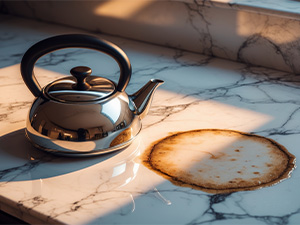
WEAR & TEAR SIGNS ON NATURAL STONE
When Your Stone Speaks, Listen
Natural stone is one of the most durable materials you can bring into your home—but even it isn’t indestructible. Over time, your stone surfaces may begin to show subtle signs of wear and distress. Learning to read these signs can save you from more costly repairs or premature replacements.
Hairline Cracks and Chips
Small cracks or chips might seem minor, but they’re often early warnings of deeper issues:
- High-traffic zones (like kitchen counters) are especially vulnerable.
- These can result from dropped items or natural shifting of the structure underneath.
- Left untreated, these cracks can expand and allow moisture in, leading to further damage.
Dullness and Etching
That beautiful, glossy finish doesn’t fade without a reason.
- Etching is usually caused by acidic substances (think: lemon juice, vinegar, wine).
- Marble and limestone are especially susceptible.
- Dull patches may signal that your stone needs professional polishing or re-sealing.
Discoloration and Staining
Color changes in your stone aren’t always age-related.
- Dark spots may indicate oil absorption (common on kitchen counters).
- Rust-colored stains can come from metal objects or even the stone’s own iron content reacting with moisture.
- Prevent future staining by having your stone professionally sealed.
Loose or Hollow-Sounding Tiles
In tiled areas, such as bathrooms or entryways, loose stone pieces are a red flag.
- This could signal adhesive failure, moisture intrusion, or shifting subflooring.
- Tapping lightly on tiles can reveal hollow spots that need attention.
- Schedule a call with your PRO when you discover problems.
Grout and Sealant Breakdown
Even if the stone itself looks fine, failing grout or sealant is a warning sign.
- Crumbling grout can let water in, damaging both the stone and the underlying structure.
- Sealants that no longer repel water need reapplication—Usage and the type of stone will dictate how often you should have your stone surfaces resealed.
Know When to Call your PRO
Early detection is key. If you notice any of these signs, it’s best to consult your stone care PRO. Regular maintenance and timely restoration can dramatically extend the life and beauty of your natural stone surfaces.
By Sharon Koehler. This article is one of a series of Caring For It™ articles written and published on behalf of Surface Care PRO Partners.
